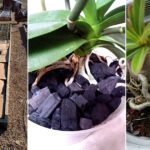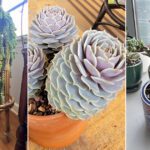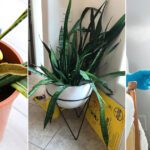Want to keep your boobie cactus in top shape but don’t know how? Check out this super helpful Boobe Cactus care guide!
Caring for a boobie cactus might seem tricky, but with this guide, it’s a breeze. This article has everything you need to keep your cactus healthy and thriving indoors.
Boobie Cactus Plant Description

Boobie cactus is a popular ornamental plant of the Cactaceae family. It can grow up to 24 inches tall with blue-green ribbed stems that look similar to breasts, hence the name. Additionally, its nipples-like curvaceous surfaces further add to the quirky resemblance.
Besides the breast-like appearance, this cactus cultivar offers tiny white spines, small berries-like fruits, and beautiful blooms in shades of yellow, pink, and red.
Botanical Name: Myrtillocactus geometrizans ‘Fukurokuryuzinboku’
USDA Zones: 8 to 11
Pot Size for Boobie Cactus
The ideal pot size for boobie cactus is typically around 4 to 6 inches in diameter. Never go with a smaller and bigger pot than the recommended one because it can negatively affect the succulent’s growth. Also, ensure the pot has proper drainage holes to avoid root rot.
Boobie Cactus Propagation

Boobie cactus can be easily propagated from offsets, cuttings, and seeds. Here are the details:
1. From Seeds
- Get fresh boobie cactus seeds either by harvesting from ripe fruit or purchasing from a reputable supplier.
- Prepare a well-draining cactus mix by combining equal parts of potting soil, coarse sand, and perlite or pumice.
- Fill a shallow tray or pot with the prepared soil mix and moisten with water.
- After that, scatter the seeds evenly across the soil’s surface, spacing them 3-4 inches apart.
- Gently press the seeds into the soil without burying them.
- Cover the tray or pot with a clear plastic cover or plastic wrap to maintain humidity.
2. From Cuttings
- Select a healthy mature boobie cactus and cut a segment of its stem with a clean, sharp knife. Make sure the cutting is at least 3-4 inches long.
- Let the cutting dry in a shaded area for a few days to form a callus.
- Once the callus appears, insert the cutting in a well-drained succulent soil mix and bury about an inch deep.
- Make sure to water the cutting sparingly to avoid sogginess.
- Place the pot in a location with plenty of bright, indirect light.
- You must be patient during the propagation process because the cutting can take several weeks to develop roots.
- Once rooted, gradually increase the watering frequency.
3. From Offsets or Pups
- Choose a healthy boobie cactus with noticeable offsets/pups.
- Use a knife to cup the pups from the parent plant.
- Let the offsets dry and callous for a few days to prevent rotting.
- Once the pups are callused, add some well-draining mix in a pot and insert the offsets gently.
- Make sure to place the pot in the bright spot with indirect light.
- Keep an eye on the root growth over the next few weeks.
- Move the plant to a bigger pot once the roots are established.
Boobie Cactus Growing Requirements

Light
Boobie cactus requires ample bright, indirect light to maintain its distinctive shape and healthy growth. Position your cactus near a south or west-facing window, where it can receive plenty of natural sunlight. However, avoid direct sunlight, as it can scorch the plant.
If your indoor space lacks sufficient natural light, supplement it with a full-spectrum, grow light. Place the grow light 12-18 inches above the cactus and provide 12-14 hours of light daily to mimic natural sunlight.
Soil
A well-draining soil mix is important for boobie cactus to prevent root rot and other issues related to excessive moisture. Use a commercial cactus mix or create one at home by combining equal parts of potting soil, coarse sand, and perlite or pumice. It’ll ensure the soil drains quickly and efficiently.
Water
Like other succulents, the boobie cactus is drought-tolerant but appreciates regular watering during the active growing season from spring to early autumn. To prevent overwatering, let the medium dry out completely in between waterings. Also, watering frequency should be reduced during the winter months.
Temperature
Boobie cactus thrives in warm temperatures – the ideal range is 60-80°F (15-27°C). However, it can thrive in lower temperatures but can’t survive in extreme chilly conditions.
Humidity
This succulent can adapt to a wide range of humidity levels, with average indoor humidity usually sufficient for its needs. Provide the plant with 40-50% humidity to ensure proper plant growth. If the humidity is too high, improve air circulation around the plant using a small fan or opening windows.
Boobie Cactus Care

Fertilizer
Boobie cactus benefits from regular fertilization during the active growing season, i.e., spring and summer. A balanced, water-soluble fertilizer diluted to half strength once every four to six weeks in the growing season is enough. Avoid over-feeding the plant, as this can damage the succulent. Also, do not fertilize the plant during winter months.
Pests and Diseases
This succulent is somewhat resistant to pests and diseases compared to other cactus varieties. However, common pests, including mealybugs, scale insects, and spider mites, can infest this plant.
In case of infestation, spray the neem oil solution on the affected spots. You can make this pest-eliminating solution at home by combining a tablespoon of neem oil, 1/2 teaspoon of liquid soap, and half a gallon of water.






